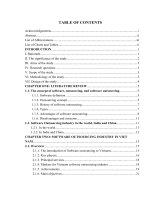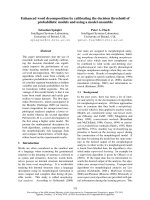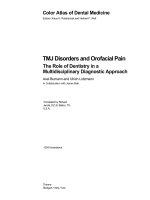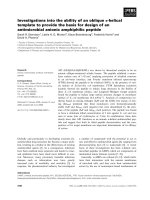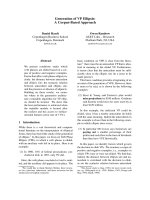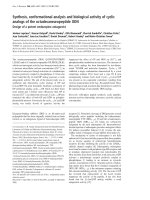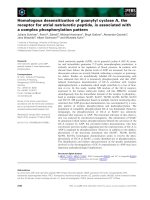automated transforms of software models a design pattern approach
Bạn đang xem bản rút gọn của tài liệu. Xem và tải ngay bản đầy đủ của tài liệu tại đây (936.66 KB, 256 trang )
AUTOMATED TRANSFORMS OF SOFTWARE MODELS:
A DESIGN PATTERN APPROACH
A thesis submitted in partial fulfillment
of the requirements for the degree of
Master of Science
By
BRANDON ADAM GUMP
B.S., Wright State University, 2008
2009
Wright State University
WRIGHT STATE UNIVERSITY
SCHOOL OF GRADUATE STUDIES
November 23, 2009
I HEREBY RECOMMEND THAT THE THESIS PREPARED UNDER MY
SUPERVISION BY Brandon Adam Gump ENTITLED Automated Transforms of
Software Models: A Design Pattern Approach BE ACCEPTED IN PARTIAL
FULFILLMENT OF THE REQUIREMENTS FOR THE DEGREE OF Master of
Science.
Thomas C. Hartrum, Ph.D.
Thesis Co-Director
Mateen M. Rizki, Ph.D.
Thesis Co-Director
Thomas A. Sudkamp, Ph.D.
Department Chair
Committee on
Final Examination
Thomas C. Hartrum, Ph.D.
Mateen M. Rizki, Ph.D.
Travis E. Doom, Ph.D.
Joseph F. Thomas, Jr., Ph.D.
Dean, School of Graduate Studies
iii
ABSTRACT
Gump, Brandon Adam. M.S., Department of Computer Science, Wright State University,
2009.
Automated Transforms of Software Models: A Design Pattern Approach.
In the realm of software development, projects are plagued by continuous
maintenance at the source code level as well as tedious transformations from formal
specifications to source code. Such work consumes a large amount of time only to create
complicated, un-intelligible, and un-reusable code that is completely detached from initial
design rational. To cope with these problems, The Air Force Institute of Technology
(AFIT) Wide Spectrum Object Modeling Environment (AWSOME) was designed to
generate specifications that can be transformed into abstract designs and finally into
source code. The specifications are written in the AFIT Wide-spectrum Language (AWL)
and parsed in by the tool into a meta-model.
The focus of this thesis is to expand AWSOME’s transform capabilities by automating
the application of design patterns to existing ASTs by altering their structure. Automating
the application of design patterns to existing software models offers many advantages
including extending reusability and easing maintenance.
iv
TABLE OF CONTENTS
Page
I. INTRODUCTION . . . . . . . . . . . . . . . . . . . . . . . . . . . . . . . . . . . . . . . . . . . . . . . . . . . . .1
II. BACKGROUND . . . . . . . . . . . . . . . . . . . . . . . . . . . . . . . . . . . . . . . . . . . . . . . . . . . . . .8
III. REQUIREMENTS ANALYSIS . . . . . . . . . . . . . . . . . . . . . . . . . . . . . . . . . . . . . . . . .29
IV. DESIGN . . . . . . . . . . . . . . . . . . . . . . . . . . . . . . . . . . . . . . . . . . . . . . . . . . . . . . . . . . .59
V. TEST RESULTS . . . . . . . . . . . . . . . . . . . . . . . . . . . . . . . . . . . . . . . . . . . . . . . . . . . . . 88
VI. CONCLUSIONS AND FUTURE WORK . . . . . . . . . . . . . . . . . . . . . . . . . . . . . . . 129
APPENDIX A. JAVA CODE GENERATED . . . . . . . . . . . . . . . . . . . . . . . . . . . . . . . . . 137
APPENDIX B. TRANSFORM SOURCE CODE . . . . . . . . . . . . . . . . . . . . . . . . . . . . . 156
BIBLIOGRAPHY . . . . . . . . . . . . . . . . . . . . . . . . . . . . . . . . . . . . . . . . . . . . . . . . . . . . . .243
v
LIST OF FIGURES
Figure Page
1.1. A typical transformation system . . . . . . . . . . . . . . . . . . . . . . . . . . . . . . . . . . . . . . . . . .2
1.2. Example of AWL syntax . . . . . . . . . . . . . . . . . . . . . . . . . . . . . . . . . . . . . . . . . . . . . . . 3
2.1. AWSOME Transformation System . . . . . . . . . . . . . . . . . . . . . . . . . . . . . . . . . . . . . . 10
2.2. A domain model of a simple library system . . . . . . . . . . . . . . . . . . . . . . . . . . . . . . . .11
2.3. A formal specification for constructors in a simple library system . . . . . . . . . . . . . .11
2.4. The result of transforming the specifications into statements . . . . . . . . . . . . . . . . . 12
2.5. The result of transforming the AWL in figure 2.4 to Java code . . . . . . . . . . . . . . . . .13
3.1. Initial design of class to represent database connection . . . . . . . . . . . . . . . . . . . . . . 30
3.2. Design class modified to eliminate pre and post-conditions . . . . . . . . . . . . . . . . . . .31
3.3: Result of applying the singleton transformation to the DatabaseConn class . . . . . . .32
vi
3.4 Singleton class diagram . . . . . . . . . . . . . . . . . . . . . . . . . . . . . . . . . . . . . . . . . . . . . . . 47
3.5: Abstract Factory class diagram . . . . . . . . . . . . . . . . . . . . . . . . . . . . . . . . . . . . . . . . . 49
3.6: Factory Method class diagram . . . . . . . . . . . . . . . . . . . . . . . . . . . . . . . . . . . . . . . . . 51
3.7: Memento class diagram . . . . . . . . . . . . . . . . . . . . . . . . . . . . . . . . . . . . . . . . . . . . . . .53
3.8: Observer class diagram . . . . . . . . . . . . . . . . . . . . . . . . . . . . . . . . . . . . . . . . . . . . . . . 54
3.9. Visitor class diagram . . . . . . . . . . . . . . . . . . . . . . . . . . . . . . . . . . . . . . . . . . . . . . . . . 56
5.1. GumpPanel user interface . . . . . . . . . . . . . . . . . . . . . . . . . . . . . . . . . . . . . . . . . . . . . 90
5.2. Input AWL file to be used with singleton transform . . . . . . . . . . . . . . . . . . . . . . . . . 91
5.3. The updated CanadaTaxProcessor class in AWL . . . . . . . . . . . . . . . . . . . . . . . . . . . .93
5.4. Input AWL file to be used with singleton usage transform . . . . . . . . . . . . . . . . . . . . 94
5.5. The AWL for the updated CanadaTaxUser class . . . . . . . . . . . . . . . . . . . . . . . . . . . .96
5.6a. Beginning of input AWL file to be used with abstract factory transform . . . . . . . . .97
vii
5.6b. Continuation of input AWL file to be used with abstract factory transform . . . . . . 98
5.6c. Continuation of input AWL file to be used with abstract factory transform . . . . . . 99
5.7a. The beginning of updated AWL file after applying abstract factory transform . . .100
5.7b. The end of updated AWL file after applying abstract factory transform . . . . . . . .101
5.8. Input AWL file to be used with abstract factory usage transform . . . . . . . . . . . . . . 102
5.9. AWL generated from executing abstract factory usage transform . . . . . . . . . . . . . .104
5.10. AWL generated from executing factory method transform . . . . . . . . . . . . . . . . . .106
5.11. AWL file to be used with factory method usage transform . . . . . . . . . . . . . . . . . . 107
5.12. AWL generated from executing factory method usage transform . . . . . . . . . . . . .109
5.13a. The beginning of AWL file to be used with memento transform . . . . . . . . . . . . .110
5.13a. Continuation of AWL file to be used with memento transform . . . . . . . . . . . . . .111
5.14a. AWL generated from executing the memento transform . . . . . . . . . . . . . . . . . . .113
viii
5.14b. Continued AWL generated from executing the memento transform . . . . . . . . . .114
5.14c. Continued AWL generated from executing the memento transform . . . . . . . . . .115
5.14d. Continued AWL generated from executing the memento transform . . . . . . . . . .116
5.15. Input AWL file to be used with observer transform . . . . . . . . . . . . . . . . . . . . . . . .116
5.16. AWL generated from executing the observer transform . . . . . . . . . . . . . . . . . . . . 118
5.17. AWL generated from executing the observer add class transform . . . . . . . . . . . . 120
5.18. Input AWL file to be used with visitor transform . . . . . . . . . . . . . . . . . . . . . . . . . 121
5.19. AWL generated from executing the add super class transform . . . . . . . . . . . . . . .122
5.20a. Beginning of AWL generated from executing the visitor transform . . . . . . . . . . 124
5.20a. Continuation of AWL generated from executing the visitor transform . . . . . . . . 125
5.21. Input AWL file to be used with add attribute transform . . . . . . . . . . . . . . . . . . . .125
5.22a. Beginning of AWL generated from executing the visitor transform . . . . . . . . . . 126
ix
5.22b. Continuation of AWL generated from executing the visitor transform . . . . . . . 127
x
LIST OF TABLES
Table Page
3.1. Summary of conclusions regarding design patterns discussed . . . . . . . . . . . . . . . . . 44
xi
ACKNOWLEDGEMENT
This thesis would not have been possible without the help of the following persons:
Dr. Hartrum, for his dedication to aiding me in every aspect of this undertaking, Drs.
Doom and Rizki, for participating on my final examination committee, previous
AWSOME students, for the work they contributed to the tool in the past, and my friends
and family, for supporting me through all the work I have done.
xii
DEDICATION
This thesis is dedicated to my loving mother, Deborah Gump. Throughout my
academic career, she has always been there to encourage me to do my best. Her
reassurance has been invaluable to forcing me to commit to my work and finish in times I
felt completely overwhelmed. Thank you, for being a wonderful mother.
1
I. INTRODUCTION
It is no secret that large scale software systems are not created error free in their
entirety from a single pass of a software lifecycle. In fact, it is the case that most
projects’ costs (as much as 70%) are expended in maintenance of code [1]. Many of
these maintenance tasks revolve not around bug fixing, but rather adding new
functionality to existing software. Classical models, such as the waterfall model, which
require each phase (e.g. design, implementation, etc.) to be completed before beginning
the next phase, make additive software enhancements difficult. To combat this setback,
the idea of evolutionary development has surfaced in which a software model is created
from initial specifications. Such a model can be iteratively improved and reused as new
specifications and requirements emerge [2]. The focus of this thesis is to design
transformations that can automatically be applied to existing software models while
supporting the idea of software evolution and preserving original system behavior.
1.1 AWSOME
In order to define a system capable of taking an existing software model that can be
iteratively improved via transforms, it is helpful to break the process into pieces.
Typically a transformation system begins with domain knowledge stored in a model
created by an engineer. Using the domain model, an engineer then constructs a formal
specification during the problem setting phase of development. The system then uses a
series of transformations and an engineer’s input to alter the requirements specification
into a design specification. Once the design specification is obtained, more transforms
can be applied by the system to create executable source code for a target platform. The
2
entire process and its participants are outlined in Figure 1.1. The underlying idea of such
an approach is that while the system can automate parts of the process, the tool should be
thought of as an aide to a software engineer who is responsible for deciding which
transformations the system should apply [3].
Figure 1.1: A typical transformation system [3].
The Airforce Institute of Technology’s Wide Spectrum Modeling Environment
(AWSOME) is a realization of such a transformation system. The system begins by
parsing in a formal specification written in AWSOME’s Wide-Spectrum Language
(AWL). AWL is based on the Object Constraint Language (OCL) and as such employs
syntax that makes it possible to design models of software systems that include classes,
associations, finite-state dynamic models, as well as class invariants and pre/post-
conditions. As shown in Figure 1.2, the language is very similar to that of a standard
object-oriented programming language [4].
3
package testpackage is
type CHAR is abstract;
type STRING is sequence of CHAR;
class Person is
private name : STRING;
public procedure setName (theName : in STRING)
assumes True
guarantees name’ = theName
is begin
name := theName;
end;
public function getName () : STRING is
begin
getName := name;
end;
end class;
end package;
Figure 1.2: Example of AWL syntax.
Once the domain model has been parsed in, it is stored in the system as an abstract
syntax tree (AST). An AST can be thought of as a model that represents the entire
software system as a collection of object classes. Each object class is a structural model
containing the class’s attributes, methods, and dynamic model (to represent state
transitions). While the system outlined in Figure 1.1 implies a sequential approach that
first creates a domain model, then a formal specification, and then a design specification,
the AWSOME tool is structured to allow the three steps to be mixed together and
interactively applied after the initial model is parsed in by the tool. Once the user is
satisfied with the transformations that have been applied to the original model, a final
transformation can be applied to the AST that turns the model into Java source code [3].
1.2 Design Patterns
Throughout a programmer’s career, it is often the case that the notion of programming
déjà vu will surface: the feeling that the problem he or she is tackling has already been
solved. Problems such as accessing an aggregate of objects sequentially without
4
exposing implementation details or providing an interface to simplify interaction with a
complicated system are but a few examples that come to mind. From a programmer’s
standpoint, it would be convenient if there were documented design strategies that
proposed solutions to these common problems and produced re-usable, flexible software.
This is precisely the goal that design patterns address through four components [5]:
1. Each design pattern has an associated name that serves as an identifier to quickly
elucidate the problem, solution, and consequences related to the design pattern
without detailing low level specifics.
2. Certainly a design pattern would be of little utility if it had no purpose. For this
reason, design patterns also describe the problems they are intended to solve. In
some cases, the problem description of a pattern can serve as a checklist of
necessary conditions that warrant the use of the pattern.
3. The heart of each design pattern is the solution itself. Since the goal of patterns
is to produce reusable and flexible code, the solution does not describe a concrete
implementation in a particular language. Rather, the solution describes an
abstract approach to organizing software components, such as classes and
functions, to solve problems.
4. While it may seem that a design pattern should be applied if it is an appropriate
solution to a problem, the consequences of applying a pattern should be
evaluated before applying it. These trade-offs are typically related to time and
space, but could directly affect the system’s extensibility and reusability.
Furthermore, the pattern may propose variants in the solution that each has its
own advantages and disadvantages.
5
1.3 Problem Statement
Currently the AWSOME tool provides support for several transformations such as
automatically generating get and set methods for all attributes specified in a model and
transforming various post-conditions to logical statements. While such transformations
are useful because they automate part of the tedious, error-prone process of generating
object-oriented code, transformations that alter the entire model structure (such as
introducing entire new classes) would be a useful addition to AWSOME’s library.
In developing this thesis, we hypothesize that it should be possible to create
AWSOME transforms that would allow an engineer to introduce design patterns into an
existing meta-model. Furthermore, in testing this hypothesis, we intend to develop a
methodology that would allow additional design pattern transforms to be developed
beyond the ones presented in this thesis. Testing this hypothesis involves altering
existing structural and functional components of AWSOME models to directly support
various design patterns. This thesis implements transformations for each of several
design patterns that may be directly applied to a model in order to alter its structure to
implement the functionality provided by each pattern. Since some patterns may require
input from a user before they can be applied, the AWSOME tool will be updated to query
such information from the user before applying such a transform. In addition, the
transformations include functionality to determine whether or not a pattern can actually
be applied to an existing model.
1.4 Appling Patterns
Since design patterns do not specify code level implementations, automated
application seems appropriate at a higher level of abstraction. For this reason, the
6
patterns will be applied at AWSOME’s meta-model level via transformations that alter
the structural model’s (AST) classes’ internal attributes and functions (the dynamic model
will remain unchanged). We postpone taking an AWL file through a complete design
pattern application until Chapter 2.
1.5 Thesis Scope
Clearly, there are far too many design patterns to explore in this thesis alone.
Furthermore, there are some patterns that are impossible to pursue due to limitations
underlying AWSOME itself (for example, some patterns rely on multiple inheritance,
which is not possible in the tool). Since restructuring the entire system is not viable, the
thesis will instead focus on patterns the existing architecture can support. However,
minor changes necessary to support patterns will be implemented to make the tool more
versatile. The patterns to be considered (though not necessarily implemented) include
abstract factory, adapter, builder, composite, decorator, façade, factory method, flyweight,
iterator, observer, singleton, strategy, and visitor. For each pattern, a detailed description
will be presented as well as a specification to describe what is to be expected when the
transform is applied. Furthermore, the underlying design and implementation of each
transform will be discussed. In order to test the transforms contributed by this thesis, we
design and anchor an interactive GUI, GumpPanel, to the existing AWSOME tool as well
as create several input AWL test files. The discussion of the testing material is postponed
until Chapter 5.
1.6 Approach
We note that creating transforms in AWSOME itself to modify an existing AST is not
a revolutionary idea contributed by this thesis. Some examples include Venkata’s work
7
with transforms that made it possible to generate executable Java code as well as
Swamy’s work to transform associations in a formal specification [6, 7]. In fact, we
follow the typical strategy of previous work by consolidating each of our transforms into
subclasses of a special class in AWSOME named Transform.
1.7 Outline
This thesis addresses the issue of implementing the automation of applying design
pattern transforms to existing AWSOME ASTs in an object oriented approach. As such
the remainder of the document is divided into the following chapters. Chapter 2 develops
a rich background of AWSOME as it relates to the thesis as well as details regarding the
design patterns included as transforms. Chapter 3 is structured as a requirements analysis
where the feasibility of implementing each pattern is explored and expected results of
each design pattern transform are clearly defined. Furthermore, the concepts of when
patterns are both applicable and appropriate are explored in this chapter. Chapter 4
addresses the specification of the previous chapter through an in-depth design of the
implementation of each transform. Chapter 5 illustrates the test results of implemented
transforms. The chapter focuses on showing application of the transforms on existing
example models. Chapter 6 closes with conclusions drawn from this thesis as well as
suggestions for future work.
8
II. BACKGROUND
2.1 AWSOME
2.1.1 Abstract Syntax Tree (AST)
If AWSOME could be thought to have a heart, truly the abstract syntax tree (AST)
used to internally represent a meta-model of a system would be it. The AST directly
stands between the initial input specification and the final output of the system. The AST
itself will be the target of modification as various transformations are applied to the
system. As such, the idea of how the meta-model represents a particular system must be
explored.
At the highest level, an AST is merely a collection of object classes that represent
the system being modeled. In essence, an object class can be thought of as an entity that
contains the name of the class, attributes related to inheritance hierarchies, as well as the
following three components:
A structural model which consists of all the attributes defined in the class.
Some design pattern transformations require inserting new attributes into a
class. The model supports the addition and removal of attributes to an existing
object class, though the functional model may have to be altered to support
changes in attributes.
A functional model which consists of all the methods defined in the class.
Again, there are design patterns that will require adding or removing functions.
The model also supports the addition and removal of methods to existing
object classes, so applying patterns transformations may also alter the
9
functional model.
A dynamic model which consists of states and transitions that define the class’s
behavior. Since design patterns alter the internal structure of the model in
order to support additional functionality and reuse, the notion of a class’s
transition through some state space is unnecessary. As such, the thesis will not
alter any dynamical models that may be associated with an object class.
2.1.2 AFIT Wide Spectrum Object Modeling Environment (AWSOME)
Recall that the typical approach taken by a semi-automated transformation system
is that of a sequential approach. In that regard, the system begins with a formal domain
model encompassing knowledge. The model is then altered by an engineer to create a
formal specification (essentially requirements) based on the problems the system needs to
solve. Finally, correctness-preserving transformations can be applied to the formal
specification to generate a design specification. The design specification itself can be
thought of as a model of the system that can be directly transformed to source code for
the target platform.
While initially AWSOME supported this step-by-step process for transformations,
the system has been updated to support a more interactive approach. AWSOME now
begins with a formal specification defined in an AWL file that is parsed in to form the
initial AST. Once the AST has been created, the tools incorporated in AWSOME are free
to modify the model in any of the development stages. This means that an engineer is
free to apply domain knowledge or formal specifications to a model as desired as well as
utilize design transformations that modify the AST. Once the user is satisfied, he or she
has the options to generate Java source code from the AST and/or generate a new AWL
10
file that could be used later again as a formal specification. Figure 2.1 illustrates the
access provided to the AST by AWSOME.
Figure 2.1: AWSOME Transformation System [3].
While the way in which AWSOME allows interaction with the AST is clear, the
notions of domain model, formal specification, and design specification must be
elaborated as they apply to the system. A domain model may be thought of as a
description of a system’s relationship between the entities it is composed of. As an
example, consider a simple library system with two main entities: libraries and books. In
such a system, the relationship in the model would be that of libraries having books. The
results of modeling this system in AWL can be seen in Figure 2.2.
11
package librarysystem is
type char is abstract;
type String is sequence of char;
type integer is range * *;
type BookArray is array[integer] of Book;
class Library is
private books : BookArray;
end class;
class Book is
private title : String;
end class;
end package;
Figure 2.2: A domain model of a simple library system.
A formal specification builds on the model by specifying what, not necessarily
how, the system’s components should do. The description is typically presented in
mathematical notation; in the case of AWSOME, specifications that closely mimic the
object constraint language (OCL) are written in AWL as a series of pre and post-
conditions for methods in each class. The results of adding formal specifications for the
constructors of components of the library system can be seen in Figure 2.3.
package librarysystem is
type char is abstract;
type String is sequence of char;
type integer is range * *;
type BookArray is array[integer] of Book;
class Library is
private books : BookArray;
public class function Library (Books : in BookArray) : Library
assumes True
guarantees this.books’ = Books and Library = new Library
is begin end;
end class;
class Book is
private title : String;
public class function Book (Title : in String) : Book
assumes True
guarantees this.title’ = Title and Book = new Book
is begin end;
end class;
end package;
Figure 2.3: A formal specification for constructors in a simple library system.
12
The final component, the design specification, is the direct product of applying
transformations to the formal specification. The transforms work to take the pre and
post-conditions and turn them into statements inside of the methods they account for. In
the case of the library system, our post-conditions simply turn into assignment statements
as can be seen in the constructor methods in Figure 2.4.
package librarysystem is
type char is abstract;
type String is sequence of char;
type integer is range * *;
type BookArray is array[integer] of Book;
class Library is
private books : BookArray;
public class function Library (Books : in BookArray) : Library
is begin
this.books := Books;
Library := new Library;
end;
end class;
class Book is
private title : String;
public class function Book (Title : in String) : Book
is begin
this.title := Title;
Book := new Book;
end;
end class;
end package;
Figure 2.4: The result of transforming the specifications into statements.
With the idea of these three components developed, it should be clear how the
model allows the user to add new domain model knowledge and specifications to the
AST and allow the system to transform the additions. When the user is satisfied with the
changes made to the AST, he or she can then generate executable Java code or a new
AWL description of the system model. An example of Java code generated can be seen
in Figure 2.5. We note that the AWSOME type BookArray appears as a class in Java
13
instead of an array. Transformation of such data types into Java code is beyond the scope
of this thesis.
package librarysystem;
/**
* File Book.java
*/
public class Book {
protected String title;
public Book(String Title) {
this.title = Title;
}
}
package librarysystem;
/**
* File Library.java
*/
public class Library {
protected BookArray books;
public Library(BookArray Books) {
this.books = Books;
}
}
Figure 2.5: The result of transforming the AWL in Figure 2.4 to Java code.
2.2 Design Patterns
At their heart, design patterns provide descriptions of common problems in computer
science as well as potential design solutions to said problems. As such, many common
programming techniques that could loosely be deemed design patterns, such as data
encapsulation or object oriented techniques, have surfaced. In the following section, we
attempt to outline many of the commonly accepted design patterns originally appearing in
the “Gang of Four” [5].
2.2.1 Singleton
In some software packages, it is the case that a particular object class may be required
to only ever have one instance. Possible situations where this may arise include
